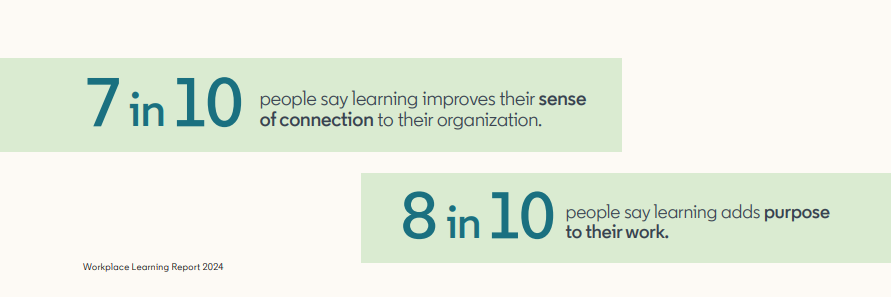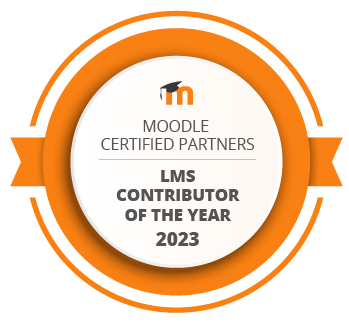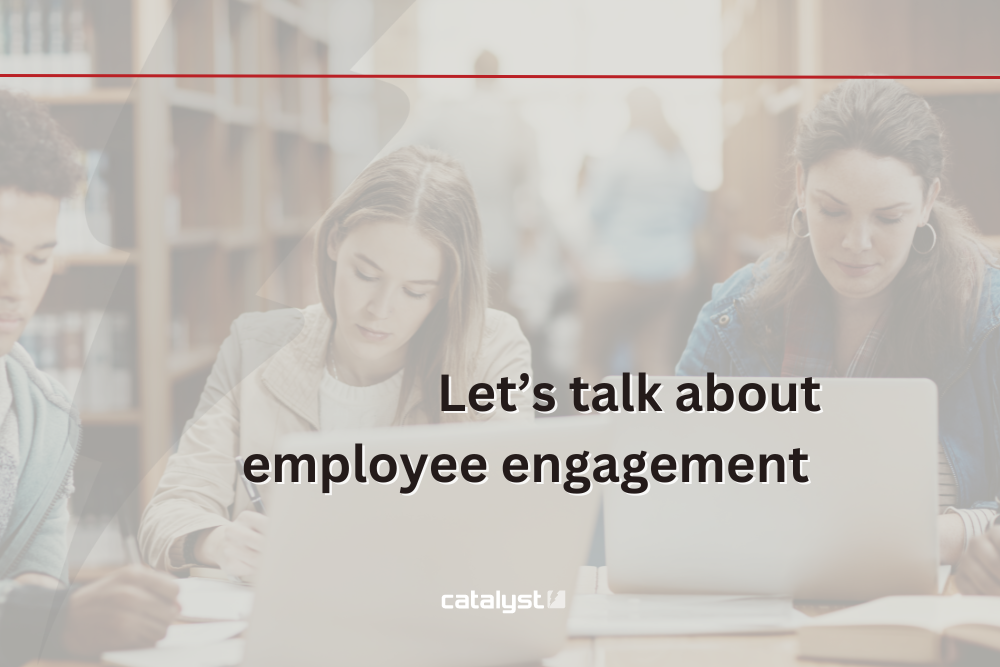Continuous education, employee engagement and your organisation’s success.
According to “The State of Employee Engagement 2023/24” report by WorkBuzz, employee engagement and retention are two of the top 5 challenges (and HR priorities) for organisations. ‘Employee performance and productivity’ is another, at number four (up six places from previous 12 months period).
It’s difficult to argue with the fact that employee performance, productivity and retention are all linked to employee engagement. But why is employee engagement becoming more and more challenging? From “neglecting employee voice” to increased organisational diversity, and from specific skill shortages to uncertainty about technologies – the reasons claimed are many and varied.
Gartner argue that the new imperatives for HR leaders include: “facilitating connectedness by intention”, “ensuring change fatigue strategies become an inherent part of change plans” and “designing adaptive, agile career paths”. These conclusions are drawn from their recent survey across 500+ leaders, in all major industries across 40 countries.
The link between continuous education and employee engagement.
‘Continuous professional development and growth’ is mentioned by various reports in the field of HR as one of the key ingredients for better employee engagement and retention.
The LinkedIn Workplace Learning Report 2024 claims that ‘helping employees develop their careers’ is an L&D priority demanding increased attention, having climbed from 9th to 4th place over the last year; and now sitting in the top 5 along with “aligning learning programs to business goals”, “upskilling” and “creating a culture of learning”. (Source)
“The findings are striking,” the report concludes, “companies with strong learning cultures see higher rates of retention (up to +57%), more internal mobility and a healthier management pipeline compared to those with smaller levels of commitment to learning.”

Source: LinkedIn Workplace Learning Report 2024
When it comes to tactics, building the right metrics – “aligning learning and business goals” – and not being “preoccupied with “vanity metrics”, such as ‘employee satisfaction’ or the number of training sessions delivered (regardless of efficacy),” is key for L&D to succeed. We couldn’t agree more.
The demand for continuous education is increasing.
More and more education providers (universities and colleges) are offering continuous learning options. This includes short courses and micro-credentialing. Not only is it an attractive income stream for these organisations but the growing demand for ‘agile upskilling’ among professionals in the workforce, means that those institutions who don’t offer it will find it difficult to remain competitive.
The rapid technological change, increasing regulatory and compliance requirements, demographic changes (ageing population) and evolution of job roles are just some of the important reasons continuous education is here to stay.
As we see from various recent HR reports, including the ones mentioned above, having clarity around individual employees’ career paths and providing access to learning and development in their workplaces are extremely important when it comes to engagement, motivation and a sense of personal achievement. Improvement in these areas will lead to positive outcomes for organisations including better rates of retention, new skill development within organisational context and even innovation.
“Continuing education is one of the fastest-growing areas in higher education, and this growth is only set to accelerate. To take advantage of this booming market, universities and colleges must adapt quickly to fulfill these adult learners’ needs.”
And so do workplaces!
The LinkedIn Workplace Learning Report 2024 states that large scale upskilling programs in organisations continue to lag. It also shows that companies that prioritise learning (have online learning programs) have more mature career development initiatives that yield [greater] positive business results. These include: leadership development programs, mentorship programs, individual career plans and greater internal mobility.
Why invest in workplace LMS?
At Catalyst, having worked with large and growing organisations for over two decades there’s one thing that’s clear: while there are so many different aspects to organisations’ overall success, those who are not afraid to invest in technological advancements see positive progress.
Of course, we are not saying you should go after every new “shiny toy” – your choice of technologies should be a part of your overall digital and higher level business goals and strategies.
10 Steps to consider when choosing an LMS for your organisation >
If you are looking to:
- Deliver effective onboarding
- Keep up with compliance training
- Keep teams connected
- Cut down on admin time
- Have a well organised and integrated ecosystem for your tech platforms
- or any combination of the above
it’s all possible if you have the right solution and a trusted support team behind it.
Here at Catalyst, we experienced this ourselves. We often hear from our new employees how efficient our onboarding process is compared to their previous employer but trust us, it hasn’t always been so.
We do have an advantage being in the LMS business ourselves, but we have also learned many lessons over time. Like with everything else (such as our cloud hosting and management practices), one of our priorities here at Catalyst is to pass on our lessons to our clients. When it comes to effective workplace learning and engagement platforms, we have a few tips to share and can recommend custom solutions to companies depending on their unique set of needs.
What is Moodle Workplace?
Built on top of core Moodle, Moodle Workplace provides all of the features found in Moodle plus these additional new features:
Onboard new employees
Automatically assign employees to courses and learning programs by role giving new starters an easy journey into your LMS. Set up automated actions based on your learner’s interactions on the platform.
Manage Compliance
Turn your learning programs into certifications and set up automated reminders for expiring certifications. Create automated recertifications and make sure you meet all legislative requirements. Customise and personalise your certificates using preferred filters.
Keep your teams connected
Integrate video-conferencing tools like BigBlueButton (BBB) or Zoom and instant messaging apps like Slack or Microsoft Teams.
At Catalyst IT Australia, in addition to using BBB for our regular team meetings and virtual events, we now use it to facilitate “virtual watercooler chats” with small groups of randomly picked people from across the company – this helps us stay connected despite the fact that we are spread all across the country.
Of course there are many more benefits to BigBlueButton than just staying connected with your work friends – you can learn more about BBB here and contact Catalyst team to help with implementation and/or to answer any further questions.
Cut down on administration time
Use dynamic rules to automate emails, assign users, award certificates and much more.
Create and organise multiple learning platforms within a single LMS site
Workplace makes it straightforward for administrators and managers to support different learning audiences by creating an ecosystem of individual learning environments in a single LMS site. Called multi-tenancy, this feature allows each site to have its own look and feel, user membership, administrators, and content, whilst also allowing sharing across tenants.
Data and Analytics
As with Moodle LMS, there are various ways you can get access to your data in your workplace LMS. Many organisations are trying to nail their data and analytics processes, and with the help of AI are using it to develop individualised learning and career paths for individuals.
While a great number of challenges exist for workplaces in our hybrid world, it is clear that the need for continuous education, ‘agile upskilling’, custom career paths and creating organisational cultures of learning and ‘connectedness’ are the things we cannot ignore.
Those who have more effective online learning platforms, and invest in technological ecosystems that integrate all the right tools for today’s hybrid work world, will see greater positive outcomes than those who do not.
You may also like:
EdTech and e-learning trends you should not ignore.
Strategies for successful compliance training in the workplace.

